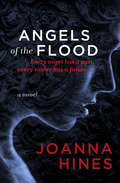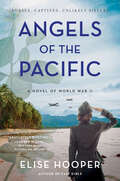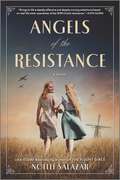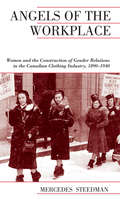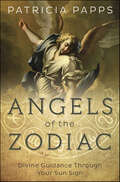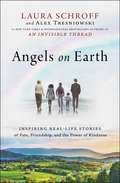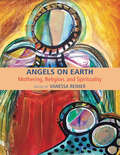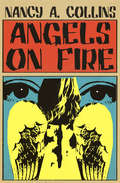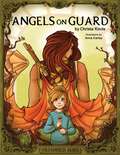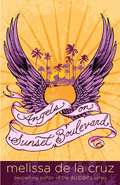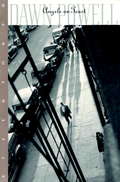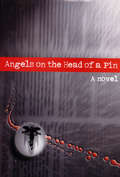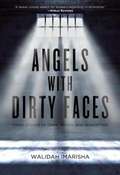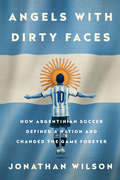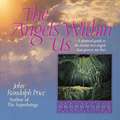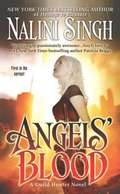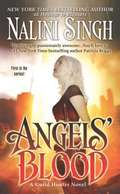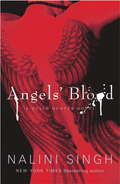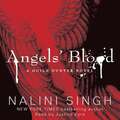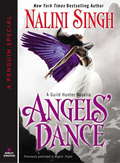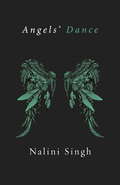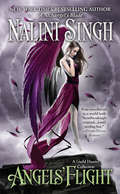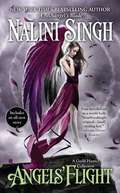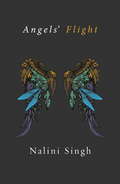- Table View
- List View
Angels of the Flood: A Novel
by Joanna HinesAn art conservator heads back to Florence, to solve the mystery of a painting and a crime that still haunts herIn 1966, when Florence's Arno River unleashed its worst flood in four hundred years, killing people and destroying much of the city, the teenage Kate Holland felt compelled to act. She became one of the "angels of the flood," helping to restore Florence, and in the process she fell in love with the city--as well as with David, one of her fellow volunteers. She also forged a transformative friendship with a local girl, Francesca. But a shattering accident left Francesca dead and forced Kate to return to England. Now a successful art conservator, Kate is plunged back into her Florentine past. David turns up at one of her lectures, and she confides to him that an anonymous dealer has been sending her some unsettling paintings. The works have been altered in ways that suggest a message for Kate specifically. For instance, a female figure is overpainted with blood that echoes Francesca's fatal injury. Determined to get to the bottom of the mystery, Kate and David set off for Italy. Francesca's family had dark secrets, and their power lingers. Are the signals in the paintings a trap, or a cry for help?
Angels of the Pacific: A Novel of World War II
by Elise Hooper"Absolutely riveting. A stay-up-all night read about two very different women who discover just how strong they can be—and just how much they'll dare—during the brutal Japanese occupation of the Philippines in World War II. This story of endurance and sisterhood will have you turning pages late into the night." —Lauren Willig, New York Times bestselling authorIf you loved Beantown Girls by Jane Healey and Hazel Gaynor’s When We Were Young & Brave, then you won’t want to miss critically acclaimed author Elise Hooper’s powerful new novel of the Angels of Bataan, nurses held as prisoners during the occupation of the Philippines in World War II.Their survival would depend on sisterhood and service.Inspired by the extraordinary true stories of World War II’s American Army nurses famously known as the Angels of Bataan and the unsung contributions of Filipinas of the resistance, this novel transports us to a remarkable era of hope, bravery, perseverance, and ultimately—victory.The Philippines, 1941: Tess Abbott, an American Army nurse, has fled the hardships of the Great Depression at home for the glamour and adventure of Manila, one of the most desirable postings in the world. But everything changes when the Japanese Imperial Army invades with lightning speed and devastating results. Tess and her band of nurses serve on the front lines until they are captured as prisoners of war and held behind the high stone walls of Manila’s Santo Tomas Internment Camp.When the Japanese occupation of her beloved homeland commences, Flor Dalisay, a Filipina university student, will be drawn into the underground network of resistance, discovering within herself reserves of courage, resilience, and leadership she never knew she possessed.As the war continues, Tess and Flor face danger, deprivation, and terror, leading them into a web of danger as they unexpectedly work together to save lives and win their freedom.
Angels of the Resistance: A WWII Novel
by Noelle Salazar&“Angels of the Resistance brings to life a deadly-effective and deeply moving sisterhood.&” —Kate Quinn, New York Times bestselling author of The Rose CodeFrom the bestselling author of The Flight Girls comes a story inspired by true events, about courageous women who risked everything for country, for family, and for each other.Netherlands, 1940As bombs fall across Europe, fourteen-year-old Lien Vinke fears that the reality of war is inescapable. Though she lives a quiet life with her mother and older sister, Elif, in their small town of Haarlem, they are no strangers to heartache, having recently suffered an immeasurable loss. And when the Nazis invade the Netherlands, joining the Dutch resistance with Elif offers just the atonement Lien craves.Trained to shoot by their late father, the sisters are deadly wolves in sheep&’s clothing. They soon find themselves entrenched in the underground movement, forging friendships with the other young recruits, and Lien even discovers a kindred spirit in a boy named Charlie. But in wartime, emotional attachments are a liability she can&’t afford, especially when a deeply personal mission jeopardizes everything she holds dear—her friendships, her family, and her one shot at redemption.&“This story of two teenage sisters who risk everything to join the Dutch Resistance is a dazzling tour-de-force.&” —Karen Robards, bestselling author of The Black Swan of Paris
Angels of the Workplace
by Mercedes SteedmanIn this renowned 1997 study of the clothing industry in Canada, Mercedes Steedman examines how the intricate weaving together of the meanings of class, gender, ethnicity, family, and the workplace created a job ghetto for women. Although women comprised a significant majority of garment workers, their roles were limited both in the workplace and in the trade union bureaucracy. Detailing the disparaties between men and women in terms of wages and representation, Angels of the Workplace is the definitive history of discrimination against women in Canada's clothing industry. Steedman shows the crucial role that women played at the front of the picket lines during labour strikes and reveals how they gained sympathy and favourable media coverage for the workers' cause. Tracing both the new hopes for more equitable work brought about by left-wing unionism, and the disappointments caused by the cooperation of labour and management in the "new unionism" of the 1930s, Angels of the Workplace reveals how formalized workplace gender discrimination was formalized for the rest of the century.
Angels of the Zodiac: Divine Guidance Through Your Sun Sign
by Patricia PappsOpen yourself to the love and wisdom of the angels of your sun sign, who reveal your life's purpose and show you how to live harmoniously each day. Angels of the Zodiac organizes the angels by the sun sign they're associated with, allowing you to easily determine which ones to connect with throughout the year.Tuning in to zodiac angels when their sign is strongest makes them more powerful, and they can use that boost to send miracles into your life. You can even connect to angels outside your sun sign at strategic times to benefit from their different energies. This book provides a meditation for connecting with each angel, guiding you through the process and the benefits that accompany it. With angels by your side, you'll achieve greater love, inspiration, and fulfillment.
Angels on Earth: Inspiring Stories of Fate, Friendship, and the Power of Connections
by Alex Tresniowski Laura Schroff"This shining book gives us story after story reminding us that God is always near." --Roma Downey "Filled with narratives about people whose lives have been changed forever by simple acts of kindness, Angels on Earth is inspiring, entertaining, and immensely readable." --Christina Baker Kline, #1 New York Times bestselling author of Orphan Train From the #1 New York Times and international bestselling authors of An Invisible Thread comes a heartwarming and inspiring book about the incredible impact that acts of kindness from strangers can have on the world around us.One day in 1986, Laura Schroff, a busy ad sales executive, passed an eleven-year-old boy panhandling on the street. She stopped and offered to take him to McDonald's for lunch. Twenty years later, at Laura's fiftieth birthday party, Maurice Mayzck gave a toast, thanking Laura for her act of kindness, which ended up changing the course of his life. In that toast, Maurice said that when Laura stopped on that busy street corner all those years ago, God had sent him an angel. Laura's invisible thread journey has deepened her belief that angels--divine and otherwise--are all around us. After An Invisible Thread was published in 2011, readers from around the country and world began sharing with Laura their own stories about how chance encounters with strangers have changed their lives. From a woman who saved a life simply by buying someone a book, to a financier who gave a stranger the greatest gift of all, to a teacher who chose a hug over discipline and changed a lost boy's future--Angels on Earth will introduce a series of remarkable people whose invisible thread stories will move, surprise, and inspire readers. Angels on Earth sheds light on how each of us can live happier, more purposeful lives through sharing acts of kindness.
Angels on Earth: Mothering, Religion, And Spirituality
by Vanessa ReimerThis collection brings together scholarly and creative pieces that reveal how the intellectual, emotional, and physical work of mothering is informed by women's religiosities and spiritualities. Its contributors examine contemporary and historical perspectives on religious and spiritual mothering through interdisciplinary research, feminist life writing, textual analyses, and creative non-fiction work. In contrast to the bulk of feminist scholarship which marginalizes women's religious and spiritual knowledges, this volume explores how such epistemologies fundamentally shape the lived experiences of diverse mothers across the globe. In emphasizing the empowerment and enrichment that women derive from their religious beliefs and spiritual worldviews, Angels on Earth invites readers to cultivate a deeper understanding of how mothers are transforming their local communities, religious institutions, and broader spiritual traditions.
Angels on Fire
by Nancy A. CollinsA struggling artist finds a lost angel has crash-landed atop her New York City apartment building, and she must help the angel become mortal or return to heaven before it turns into a daemon Struggling artist Lucy Bender is at the end of her rope. After being betrayed by both her boyfriend and a jealous rival in the cut-throat art world, she finds herself standing on the roof of her New York apartment, contemplating suicide. Her luck is changed, however, when a misplaced angel named Joth plummets to Earth, landing at her feet. Lucy&’s first thought is to alert the media, in the form of a sleazy reality TV show. But her dreams of instant fame and fortune are cut short when she discovers she&’s the only person who can see Joth for what it truly is. Making things even more difficult is the realization that the downed angel is attracting attention from servants of the Infernal Machine, led by the daemon Meresin, who is eager to add Joth to his roster of imps and devils. Lucy is befriended by Ezrael, who was once like Joth and is now a wandering Muse. Ezrael warns her if Joth fails to find its way back to where it came from, it will automatically become a daemon, unless it chooses to become mortal. The only catch is that angels don&’t have free will. Can Lucy save her fallen angel from falling farther still? And is she willing to knock on heaven&’s door to do so?
Angels on Guard (Threshold Series)
by Christa J. KindeEven after three years, Prissie Pomeroy’s guardian angel understood only part of what it meant to watch over one precious life. The rest he learned on the day he almost lost her. In this free illustrated companion story to the Threshold Series, scars are bared, fears begin and end, and angels fall. Includes a bonus chapter from Book #1 in the Threshold series, The Blue Door!
Angels on Sunset Boulevard
by Melissa de la CruzPay to get in, Pray to get out. Johnny Silver is the world's soon-to-be biggest rock star, but on the eve of his debut concert in Los Angeles, he mysteriously disappears, causing global pandemonium. His friend Taj tries to discover the truth about his disappearance, which leads her to TAP.com and its shadowy founder, Sutton Werner, who throws the wildest parties in Bel-Air. TAP started out innocently enough, as a website that dishes the dirt on the kids of Sunset Boulevard and beyond. But it has become something more. Membership is a privilege with responsibilities and consequences. At Sutton's parties, anything goes, especially in the legendary backroom rituals nicknamed The Angels Practice. Rumors abound of a special drink handed out at the parties that tap into otherworldly sensations. One night Taj meets Nick, a Westside preppie who doesn't buy into the TAP mayhem, especially since his kid sister never came home from attending one of its blow-out bashes. Slowly the two of them are drawn to TAP and to each other. But Taj just might know more than she's letting on.... Are you ready for the darker side of Tinsel-town's brightest lights?
Angels on Toast
by Dawn PowellEVERYONE IN Dawn Powell's New York satire Angels on Toast is on the make: Lou Donovan, the entrepeneur who ricochets frantically between his well-connected current wife, his disreputable ex, and his dangerously greedy mistress; Trina Kameray, the exotic adventuress whose job title is as phony as her accent; T.V. Truesdale, the man with the aristocratic manner, the fourteen-dollar suit, and the hyperactive eye for the main chance. A dizzyingly fast-paced and deliriously entertaining novel.From the Trade Paperback edition.
Angels on the Head of a Pin: A Novel
by Thomas Moore Yuri DruzhnikovIn this contemporary Russian classic, a samizdat document arrives at a Soviet newspaper headquarters with unimaginable consequences.Angels on the Head of a Pin is set in Moscow in the late 1960s, at a time when Khrushchev-era liberalization is being threatened by the return to personality cult and repression following the Soviet intervention in Czechoslovakia. The editor-in-chief of the organ of the Communist Party collapses with a heart attack outside the Central Committee building. This is partly brought on by the appearance of a samizdat manuscript on his desk that leads to his anguishing over who left it there and what to do with it to avoid falling victim to the malevolence its content is likely to unleash. The solution lies with Yakov Rappoport, an ageing and cynical Jewish veteran of the war and two spells in the Gulag, the author of not only the obnoxious popular campaigns sponsored by the newspaper (and all its letters to the editor) but of every speech that gets made in public by the principals of the regime as well. His efforts to help his stricken editor, as well as the novel's star-crossed lovers, lead to a hallucinatory climax.
Angels with Dirty Faces
by Walidah Imarisha"There was a time I believed prisons existed to rehabilitate people, to make our communities safer. . . . When I saw for the first time (but not the last) a mother sobbing and clutching her son when visiting hours were up, only to be physically pried off and escorted out by guards, I knew nothing about that made me safer. This is the heart of this country's prison system. And the prison system has become the heart of America."--Walidah Imarisha, from the introduction.This is no romanticized tale of crime and punishment. The three lives in this creative nonfiction account are united by the presence of actual harm--sometimes horrific violence. Walidah Imarisha, a sexual assault survivor, brings us behind prison walls to visit her incarcerated brother Kakamia and his fellow inmate Jimmy "Mac" McElroy, a member of the Irish gang the Westies. Together they explore the questions: People can do unimaginable damage to one another--and then what? What do we as a society do? What might redemption look like?Imarisha doesn't flinch as she guides us through the complexities and contradictions of transformative justice, eschewing theory for a much messier reality. The result is a nuanced and deeply personal analysis that allows readers to connect emotionally with the stories she shares, and the people behind them.Walidah Imarisha is a writer, organizer, educator, and spoken-word artist. She is the co-editor of Octavia's Brood: Science Fiction Stories From Social Justice Movements and author of the collection of poetry Scars/Stars.
Angels with Dirty Faces: How Argentinian Soccer Defined A Nation And Changed The Game Forever
by Jonathan WilsonThe Masterful, Definitive History of Argentinian SoccerLionel Messi, Diego Maradona, Alfredo Di Stéfano: in every generation Argentina has uncovered a uniquely brilliant soccer talent. <P><P> Perhaps it's because the country lives and breathes the game, its theories, and its myths. Argentina's rich, volatile history—by turns sublime and ruthlessly pragmatic—is mirrored in the style and swagger of its national and club sides. <P>In Angels with Dirty Faces, Jonathan Wilson chronicles the operatic drama of Argentinian soccer: the appropriation of the British game, the golden age of la nuestra, the exuberant style of playing that developed as Juan Perón led the country, a hardening into the brutal methods of anti-fútbol, the fusion of beauty and efficacy under César Luis Menotti, and the emergence of all-time greats.
Angels within Us: A Spiritual Guide to the Twenty-two Angels That Govern Our Lives
by John Randolph PriceTHE ANGELS WITHIN US shows how to pinpoint your own trouble spots, discover which angel waits beyond reach, and ask it for guidance. In a step-by-step process that includes meditations, practical exercises, and examples of angelic conversations experienced by the author and others, you will meet the Angel of Unconditional Love and Freedom, catalyst of all angels. You will then learn about the twenty-one other angels whose energies are attuned to such realms as: Illusion and Reality; Creative Wisdom; Abundance; Power and Authority, and more. THE ANGELS WITHIN US guides you to that exalted and natural existence where you can be as cosmically whole, vibrant, strong, and free as you were created to be.From the Trade Paperback edition.
Angels' Blood
by Nalini SinghFIRST IN THE GUILD HUNTER SERIES from "a major new talent" (CHRISTINE FEEHAN).View our feature on Nalini Singh's Angels' Blood.Nalini Singh introduces readers to a world of beauty and bloodlust, where angels hold sway over vampires.Vampire hunter Elena Deveraux is hired by the dangerously beautiful Archangel Raphael. But this time, it's not a wayward vamp she has to track. It's an archangel gone bad.The job will put Elena in the midst of a killing spree like no other--and pull her to the razor's edge of passion. Even if the hunt doesn't destroy her, succumbing to Raphael's seductive touch just may. For when archangels play, mortals break.
Angels' Blood
by Nalini SinghFIRST IN THE GUILD HUNTER SERIES from "a major new talent" (CHRISTINE FEEHAN).View our feature on Nalini Singh's Angels' Blood.Nalini Singh introduces readers to a world of beauty and bloodlust, where angels hold sway over vampires.Vampire hunter Elena Deveraux is hired by the dangerously beautiful Archangel Raphael. But this time, it's not a wayward vamp she has to track. It's an archangel gone bad.The job will put Elena in the midst of a killing spree like no other--and pull her to the razor's edge of passion. Even if the hunt doesn't destroy her, succumbing to Raphael's seductive touch just may. For when archangels play, mortals break.
Angels' Blood (Guild Hunter, Book #1)
by Nalini SinghNew York Times bestselling author Nalini Singh introduces a world of beauty and bloodlust where angels hold sway over vampires... Vampire hunter Elena Deveraux knows she is the best--but she does not know if even she is good enough for this job. Hired by the dangerously beautiful archangel Raphael, a being so lethal that no mortal wants his attention, Elena knows failure Is not an option--even if the task is impossible. Because this time, it's not a wayward vamp she has to track. It's an archangel gone bad. The job will put Elena in the midst of a killing spree like no other--and pull her to the razor's edge of passion. Even if the hunt does not destroy her, succumbing to Raphael's seductive touch just might. For when archangels play, mortals break...
Angels' Blood: Book 1 (The Guild Hunter Series)
by Nalini SinghVampire hunter Elena Deveraux knows she's the best - but she doesn't know if she's good enough for this job. Hired by the dangerously beautiful Archangel Raphael, a being so lethal that no mortal wants his attention, only one thing is clear - failure is not an option ... even if the task she's been set is impossible. Because this time, it's not a wayward vamp she has to track. It's an archangel gone bad. The job will put Elena in the midst of a killing spree like no other ... and pull her to the razor's edge of passion. Even if the hunt doesn't destroy her, succumbing to Raphael's seductive touch just may. Because when archangels play, mortals break ...
Angels' Blood: Book 1 (The Guild Hunter Series)
by Nalini SinghVampire hunter Elena Deveraux knows she's the best - but she doesn't know if she's good enough for this job. Hired by the dangerously beautiful Archangel Raphael, a being so lethal that no mortal wants his attention, only one thing is clear - failure is not an option... even if the task she's been set is impossible. Because this time, it's not a wayward vamp she has to track. It's an archangel gone bad. The job will put Elena in the midst of a killing spree like no other... and pull her to the razor's edge of passion. Even if the hunt doesn't destroy her, succumbing to Raphael's seductive touch just may. Because when archangels play, mortals break...Read by Justine Eyre(p) 2010 Tantor, Inc
Angels' Dance
by Nalini SinghAn angel finds passion and danger in the arms of an unexpected lover in Nalini Singh's New York Times bestselling series that "may do for angels what [Christine] Feehan did for vampires" (Dear Author)... The gentle teacher of angelic young, and the keeper of her people's histories, Jessamy is respected and admired by everyone who knows her. Yet, born unable to soar into flight, she has spent thousands of years trapped in the mountain stronghold of the Refuge, her heart encased in painful loneliness...until the arrival of Galen, warrior angel from a martial court. Rough-edged and blunt, Galen is a weapons-master at home with violence, a stranger to the sweet words it takes to woo a woman--but he is also a man determined to claim Jessamy for his own, to dance with her through the skies denied her for so very long...even if their exhilarating passion proves as dangerous as the landscape of war and unrest that lies before them. Angels' Dance previously appeared in the anthology, Angels' Flight .
Angels' Dance: A Guild Hunter Novella (The Guild Hunter Series)
by Nalini SinghA never-before published novella set in the world of Nalini Singh's Guild Hunter seriesWarrior angels, vampire hunters and angels gone bad heat up this altogether sizzling paranormal alternate universe, from the bestselling author Nalini Singh.Angels' Dance is a compelling story of passion, love and danger in the Guild Hunter world. Jessamy, a beautiful flightless angel, has always held her own in the world of angels and archangels ... until she meets Galen and begins to dream of flying ...Galen is fierce and passionate, but he finds himself growing protective towards Jessamy: so vulnerable, and so strong at the same time. It's clear there is something growing between them; will they find a way to dance together?This is a compelling, sexy addition to the Guild Hunter universe.
Angels' Flight
by Nalini SinghWarrior angels, vampire hunters, and angels gone bad heat up this altogether sizzling paranormal alternate universe. This anthology of novellas features Angels' Wolf, Angels' Judgement, Angels' Pawn, and the never-before-published Angels' Dance.
Angels' Flight (A Guild Hunter Collection)
by Nalini SinghIn Angel's Wolf a vampire becomes fascinated with the seductive angel who rules Louisiana. But all is not what it appears to be in her court. In Angels' Judgment a hunter must track one of her own gone bad, while surviving the deadly tests placed in her way by the archangels themselves. Unexpected backup comes from a stranger who might just be the most lethal threat of all... Plus FIRST TIME IN PRINT In Angels' Pawn a vampire hunter faces off against two rival factions and the angel manipulating them both, and a vampire whose help is not entirely selfless... And NEVER BEFORE PUBLISHED In Angels' Dance an angel trapped in the mountain stronghold of the Refuge finds herself under siege by a warrior angel from a martial court.
Angels' Flight: A Guild Hunter Collection (The Guild Hunter Series)
by Nalini SinghWarrior angels, vampire hunters and angels gone bad heat up this altogether sizzling paranormal alternate universe.This anthology of novellas features Angels' Wolf, Angels' Judgement, Angels' Pawn and the never-before-published Angels' Dance.
